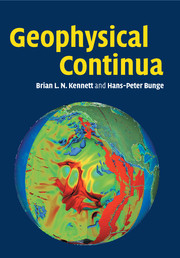Book contents
- Frontmatter
- Contents
- Preface
- 1 Introduction
- PART I CONTINUUM MECHANICS IN GEOPHYSICS
- PART II EARTH DEFORMATION
- 9 From the Atomic Scale to the Continuum
- 10 Geological Deformation
- 11 Seismology and Earth Structure
- 12 Lithospheric Deformation
- 13 The Influence of Rheology: Asthenosphere to the Deep Mantle
- 14 Mantle Convection
- 15 The Core and the Earth's Dynamo
- Appendix: Table of Notation
- Bibliography
- Index
14 - Mantle Convection
from PART II - EARTH DEFORMATION
Published online by Cambridge University Press: 17 March 2011
- Frontmatter
- Contents
- Preface
- 1 Introduction
- PART I CONTINUUM MECHANICS IN GEOPHYSICS
- PART II EARTH DEFORMATION
- 9 From the Atomic Scale to the Continuum
- 10 Geological Deformation
- 11 Seismology and Earth Structure
- 12 Lithospheric Deformation
- 13 The Influence of Rheology: Asthenosphere to the Deep Mantle
- 14 Mantle Convection
- 15 The Core and the Earth's Dynamo
- Appendix: Table of Notation
- Bibliography
- Index
Summary
The Navier–Stokes equation introduced in Chapter 7 provides the basis for understanding the behaviour of mantle convection. Because the mantle is highly viscous, the dominant contributions to the momentum balance come from viscous and buoyancy forces. This means that a scaling analysis from boundary layer theory can be used to compute mantle convection velocities from estimates of mantle viscosity and buoyancy forces. The peculiar geometry, or planform, of mantle convection cells, with subduction zones separated by distances several times the mantle depth, results from a strong increase in mantle viscosity with depth. The internal mantle temperature distribution departs considerably from the adiabat, because the mantle overturns slowly in a time comparable to the internal heat production time scale and the rate of secular cooling. The topography associated with cooling of the oceanic lithosphere and with hot spot swells gives a useful reference to constrain the ratio of internal mantle heating relative to the heat flux coming from the core, although the topography associated with plumes must be corrected for non-adiabatic effects. The Mesozoic and Cenozoic circulation of the mantle can be inferred from plate motion histories, although a limitation is the lack of information on initial conditions.
Convective forces
We start by providing a simple treatment of convection based on boundary layer theory, and we will see that this provides velocities of the size associated with plate motion (Figure 14.1).
- Type
- Chapter
- Information
- Geophysical ContinuaDeformation in the Earth's Interior, pp. 330 - 378Publisher: Cambridge University PressPrint publication year: 2008



